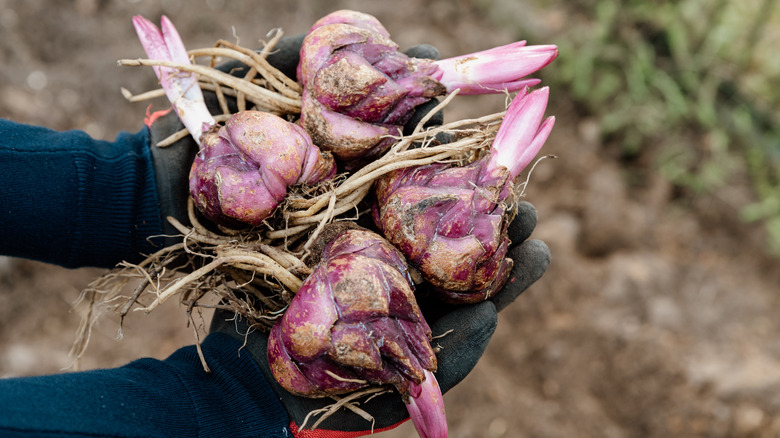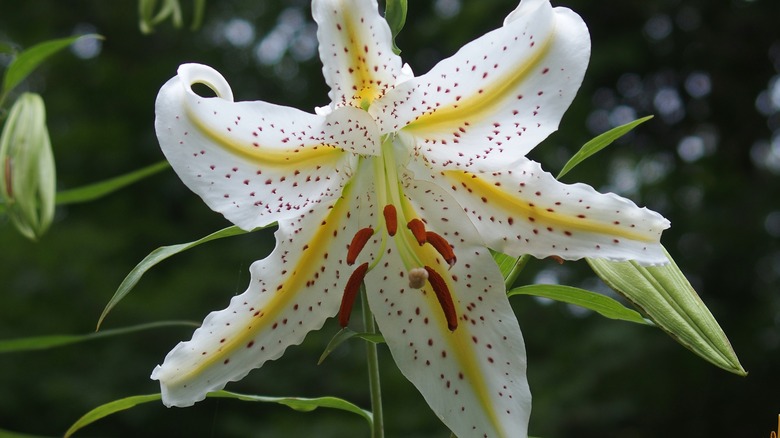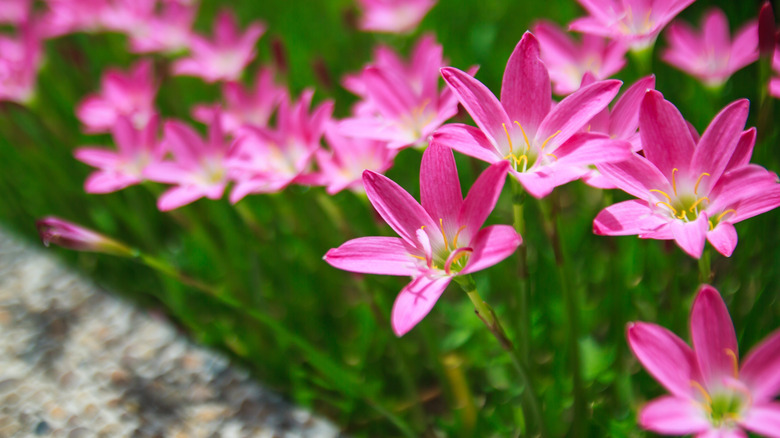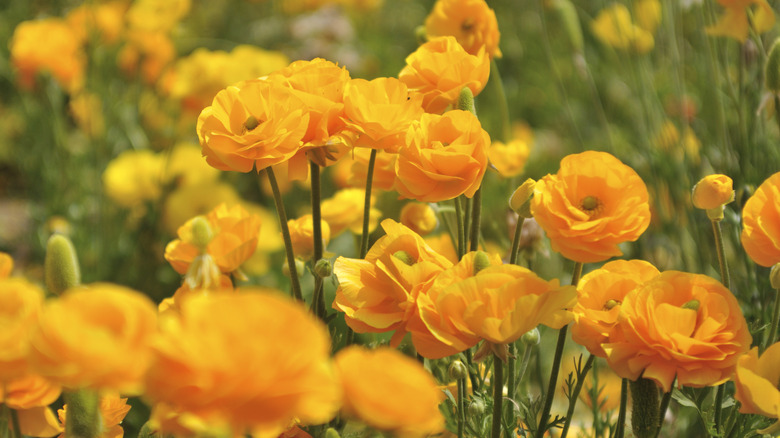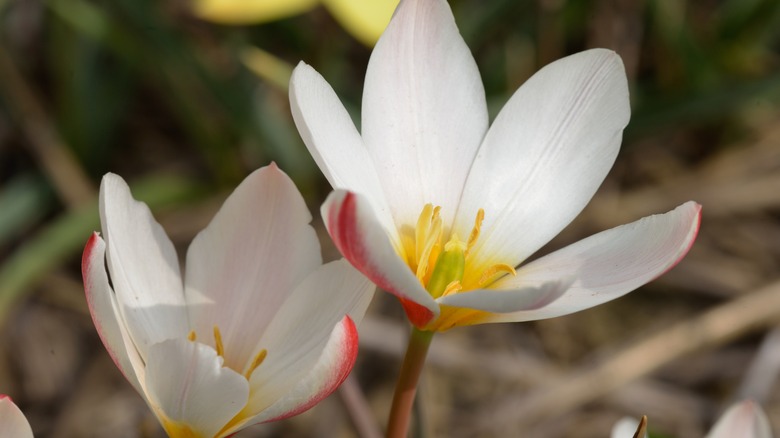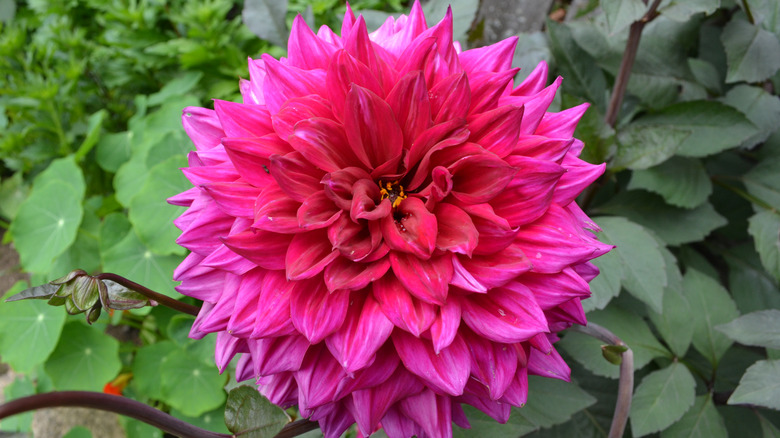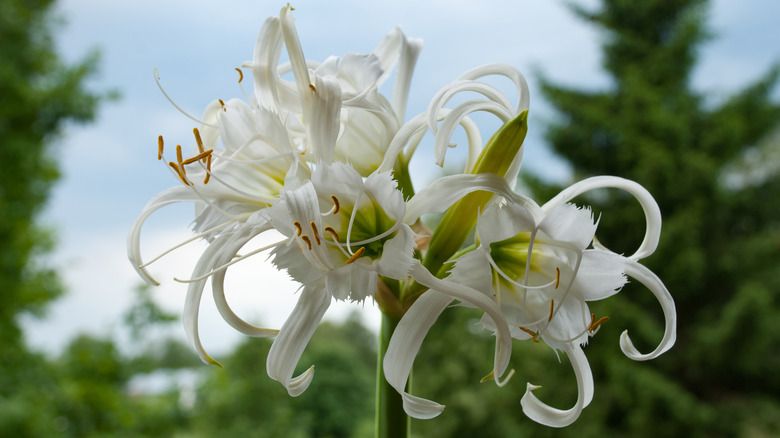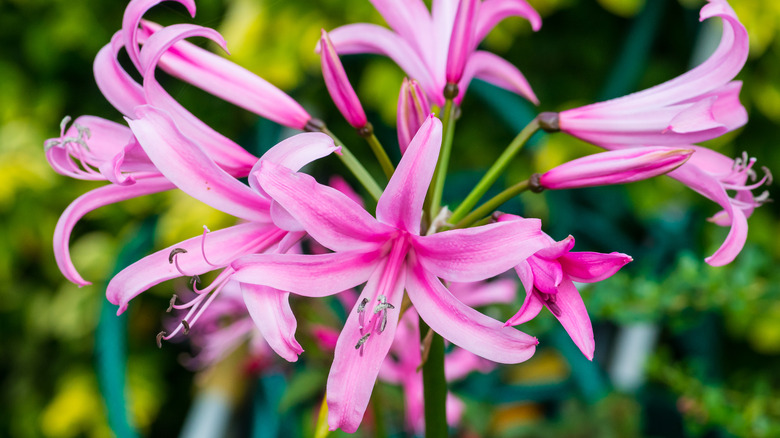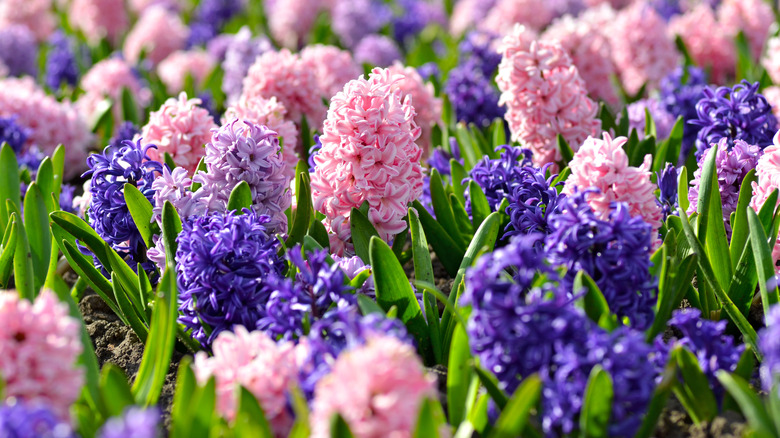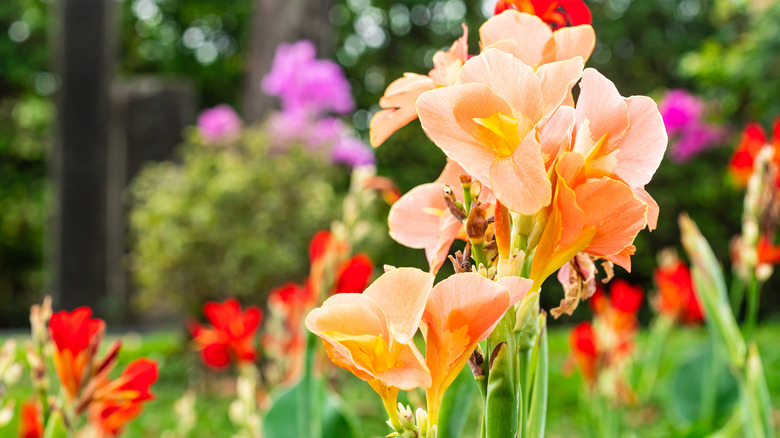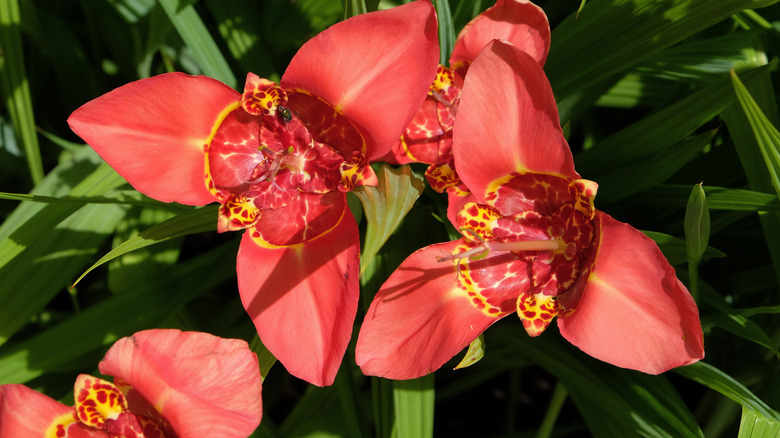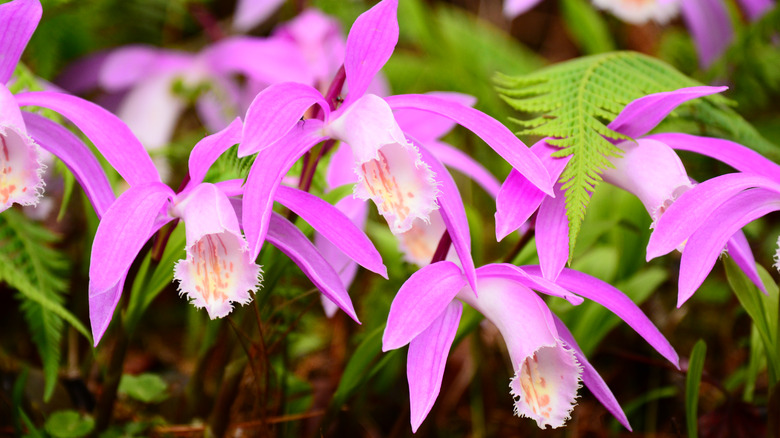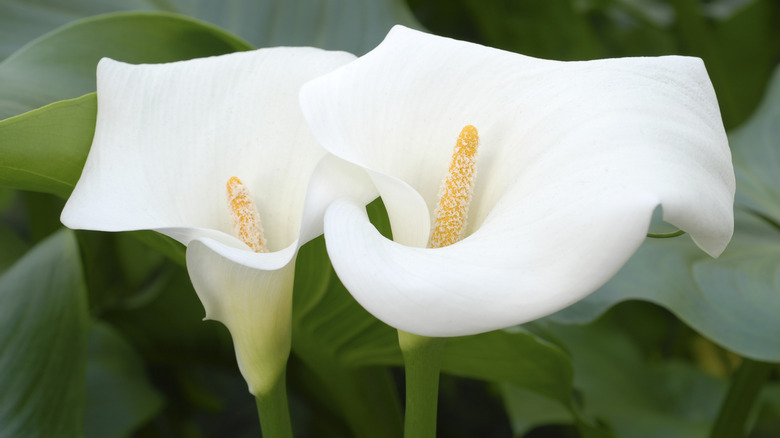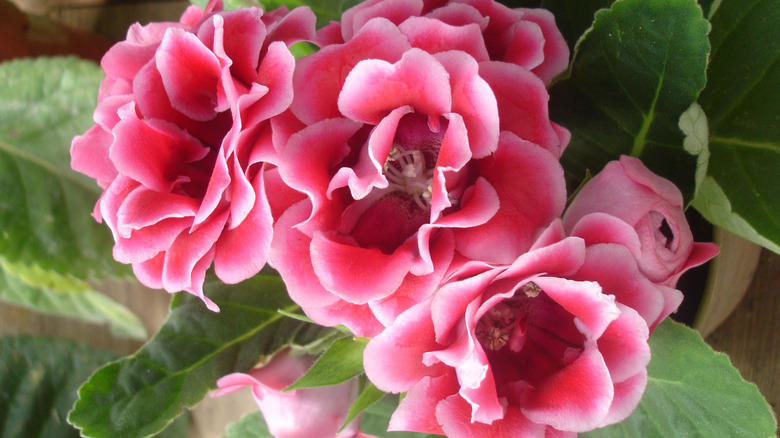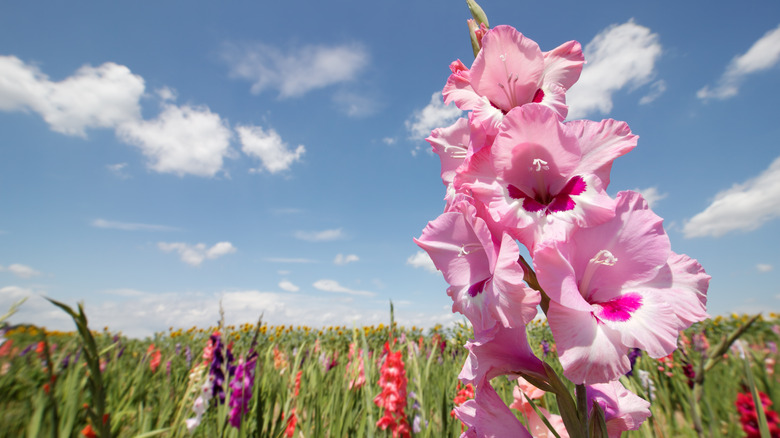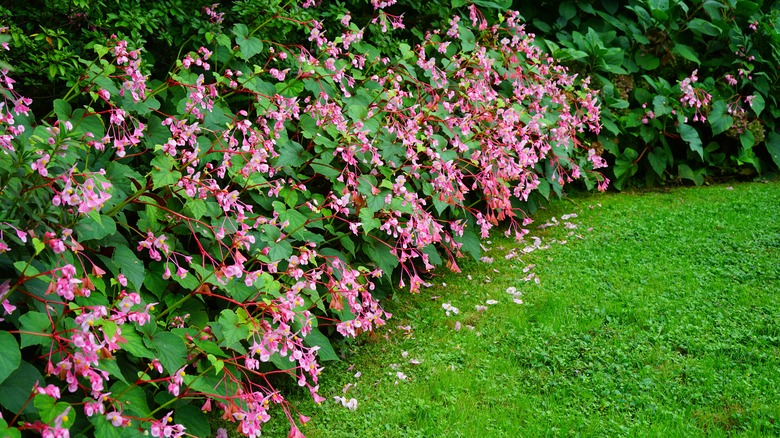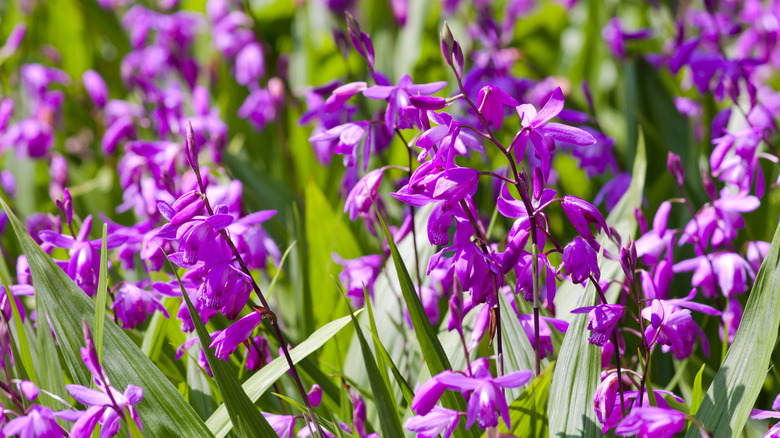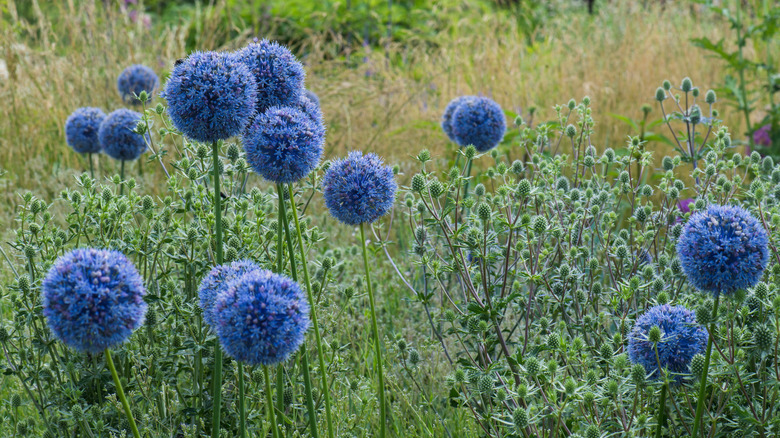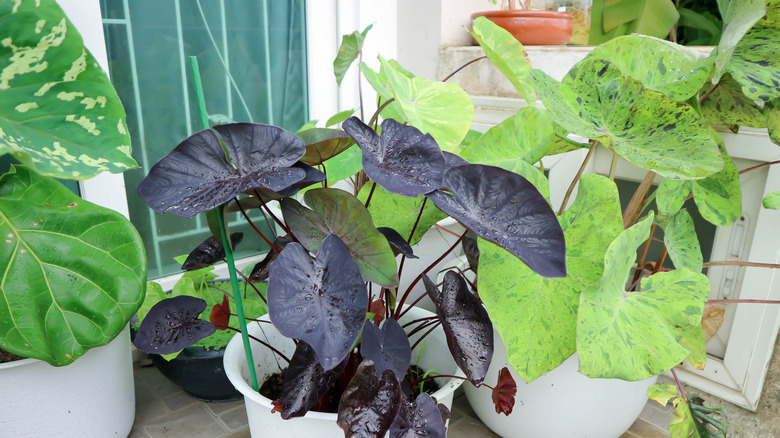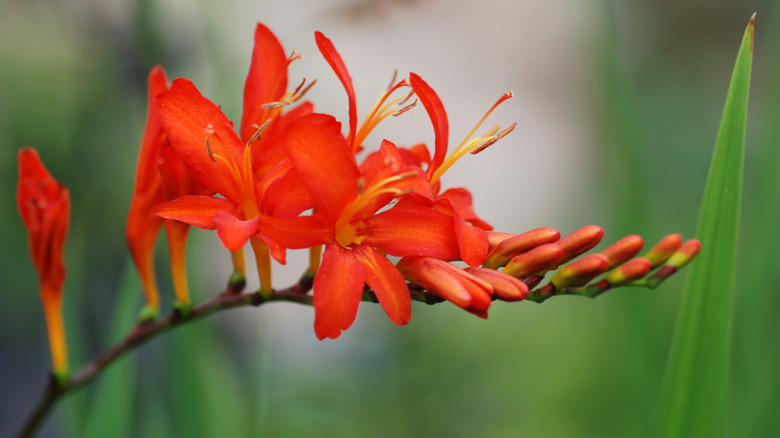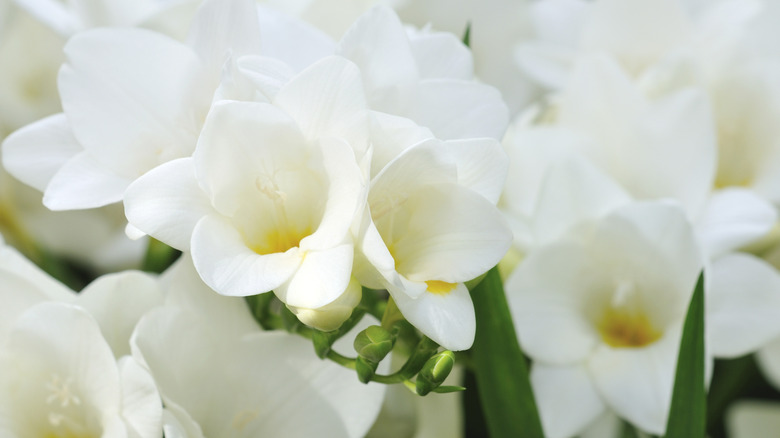20 Bulbs You Should Be Planting In Your Garden This Spring
In general, flower bulbs are planted in the fall, so they can sprout right up as the soil becomes warm with the spring weather. However, if you missed your opportunity months ago, you can instead get in on the action with a few species that will produce gorgeous flowers and foliage for you to enjoy through the end of spring, into summer, and some even last until the first frost.
While it's too late for true daffodils and crocus species, lily flower bulbs are ready to be planted right now. Additionally, some bulb-like plants that use corms, tubers, and rhizomes are ready, too, and they're grown just like bulbs. They include dahlia, gladiolus, colocasia, and caladium species, which are unopposed by smaller blooms like crocus.
Nearly all of these bulb and bulb-adjacent plantings are just as simple to grow as other spring bulbs, and you can do it while the weather is getting warm. Simply dig the right size hole for your plant, pop in a bulb, and wait for it to grow. Your blooming summer garden is closer than you think. Just take a look at this collection of spring-planted bulbs.
1. Golden-rayed lilies
Golden-rayed lilies (Lilium auratum), also known as goldband lilies, are relatively easy to grow. This is especially true when you make sure their soil is never too wet and the shade cast on them isn't too heavy. The roots of your lilies should be kept cool; if they're positioned in direct sunlight, consider using mulch at the base of the plants to prevent the soil from heating up and drying out.
Bloom Season: Summer
USDA Growing Zone: 5 to 8
Growing Conditions: Full sun to partial shade
Soil Type: Well-draining
Size: 2 to 5 feet tall
2. Rain lilies
Rain lilies (Zephyranthes grandiflora) are members of the amaryllis family, and therefore they're not actually true lilies. Still, they are just as beautiful and frequently chosen for their gorgeous pink flowers and grass-like leaves. Rain lilies take their name from one exciting habit of theirs: They normally bloom right after heavy rainfall.
Bloom Season: Summer
USDA Growing Zone: 7 to 10
Growing Conditions: Full sun to partial shade
Soil Type: Rich and well-draining
Size: 9 to 12 inches tall and 12 to 18 inches wide
3. Persian buttercups
Persian buttercups (Ranunculus asiaticus) are cup-shaped flowers composed of delicate petals. The blooms are available in a range of colors, including red, pink, purple, yellow, white, and hybrid bi-color options. The buttercups begin to bloom toward the end of spring for an incredible show once summer begins. They're sun-loving plants that can withstand hotter temperatures during the summer, however, they survive best during the cooler weather of spring.
Bloom Season: Spring to summer
USDA Growing Zone: 8 to 10
Growing Conditions: Full sun
Soil Type: Evenly moist and well-draining
Size: 1 to 2 feet tall and wide
4. Lady tulips
Lady tulips (Tulipa clusiana) are a unique tulip species that boast slender stems and elegant blooms. They grow best in the colder parts of the United States where the summers are dry and the winters are wet. Lady tulips are typically easy to grow and have minimal care requirements after blooming. They also have very few pests and diseases, however, they're quite tasty to rodents and other native wildlife species.
Bloom Season: Spring
USDA Growing Zone: 3 to 7
Growing Conditions: Full sun
Soil Type: Fertile and well-draining
Size: 9 to 12 inches tall and wide
5. Dinner-plate dahlia
The dinner-plate dahlia (Dahlia 'Emory Paul') is widely known for its giant blooms that are normally 12 to 14 inches in diameter. These flowers, which are literally the size of a dinner plate, are thankfully long bloomers that often last from the middle of summer to the end of fall. As you might already suspect, the dahlia flowers can be quite expensive, especially if you plan to purchase several.
Bloom Season: Summer to fall
USDA Growing Zone: 2 to 10
Growing Conditions: Full sun
Soil Type: Acidic and well-draining
Size: 36 to 40 inches tall
6. Peruvian daffodils
Peruvian daffodils (Hymenocallis x festalis) are hybrid flowers that may be more commonly known as spider lilies. They show off a distinctive shape that includes a conical but flaring blossom surrounded by several skinny reflexed petals that create their spider-like silhouette. Often, Peruvian daffodils are grown for cutting as they boast a delightful fragrance and look great in a vase.
Bloom Season: Summer
USDA Growing Zone: 3 to 10
Growing Conditions: Full sun to partial shade
Soil Type: Loamy and well-draining
Size: 12 to 24 inches tall
7. Guernsey lilies
Another member of the amaryllis family, the guernsey lily (Nerine bowdenii) is an interesting flowering plant that only shows off its long and narrow green leaves for most of the season. Yet, as summer comes to an end, the plant erupts with as many as 10 flowers all grouped on one stalk. The blooms may range in color from bright pink to white.
Bloom Season: Summer to fall
USDA Growing Zone: 7 to 11
Growing Conditions: Full sun
Soil Type: Rich and well-draining
Size: 1 to 2 feet tall
8. Common hyacinths
Hyacinths (Hyacinthus orientalis) are sweet-smelling and spring-blooming flowers that grow from bulbs. Because they're much more hardy compared to other bulbs, people around the U.S. enjoy planting them in large quantities to edge beds or decorate landscapes. Keep in mind that nearly all parts of the plant are somewhat poisonous to humans and pets, so be careful not to plant them in areas where children, dogs, and cats play.
Bloom Season: Spring
USDA Growing Zone: 4 to 8
Growing Conditions: Full sun to partial shade
Soil Type: Rich and well-draining
Size: 8 to 12 inches tall
9. Canna lilies
Canna lilies (Canna indica), also referred to as African arrowroot, are edible perennial plants with a long history of cultivation in Central and South America. It grows best in warm climates that offer moist soil and plenty of sunlight. Yet, it's still grown in colder regions as an annual. Like other bulbs, one of canna lilies' biggest threats is prolonged moisture around their roots that can lead to rot.
Bloom Season: Summer
USDA Growing Zone: 8 to 11
Growing Conditions: Full sun to partial shade
Soil Type: Evenly moist and well-draining
Size: 1 to 8 feet tall
10. Tiger flowers
Tiger flowers (Tigridia pavonia) are relatively short-growing plants that may be confused with gladiola flowers before blooming. Like canna lilies, tiger flowers are native to Central and South America where they've been used as a food crop for many years. In your garden, you can choose to grow them in several colors, including orange, pink, red, and white. All cultivars of the species can be identified by their red or pink spotted centers.
Bloom Season: Summer
USDA Growing Zone: 8 to 10
Growing Conditions: Full sun to partial shade
Soil Type: Well-draining
Size: 1 to 2 feet tall
11. Pleione orchids
Pleione orchids (Pleione formosana) are another type of short-growing plant, however, its blooms are nearly as big as the stem beneath them. To grow properly, they need quite a bit of shade and protection from the wind. They do well growing beneath trees and other larger plants such as pine trees or tall bushes.
Bloom Season: Spring
USDA Growing Zone: 8 to 11
Growing Conditions: Partial shade to full shade
Soil Type: Well-draining
Size: 4 to 5 inches tall
12. Calla lilies
Calla lilies (Zantedeschia spp.), which have just eight species in their genus, are very popular house and garden plants that are commonly recognized from their flowers. The petal-like spathe that wraps on top of itself is commonly confused for the flower. In reality, the true flowers are tiny and located inside the spathe. Unlike many bulbs in this collection, calla lilies prefer moist to wet soil that offers constant hydration.
Bloom Season: Spring
USDA Growing Zone: 7 to 10
Growing Conditions: Full sun to partial shade
Soil Type: Moist and hummus-rich
Size: 1 to 3 feet tall
13. Gloxinia
Gloxinia (Sinningia speciosa) is a shade-loving plant despite needing temperatures consistently above 60 degrees Fahrenheit. This somewhat finicky flower is related to African violets and features similar velvety leaves that the houseplant is known for. Like their relative, gloxinia also performs well as a houseplant, so if you don't live in the right USDA growing zone you can still enjoy its gorgeous flowers.
Bloom Season: Spring
USDA Growing Zone: 11 to 12
Growing Conditions: Partial shade to full shade
Soil Type: Peaty and well-draining
Size: 6 to 12 inches tall and wide
14. Gladioli
Gladioli plants (Gladiolus spp.) produce blooms on tall stalks, sort of like hyacinths. These blooms come in many different colors to match any garden aesthetic. They're also simple to care for, so beginners don't have to stress. Keep in mind that the bloom time of these flowers depends on when you plant the bulbs. Consider planting them throughout the spring and summer to continually see the blossoms during the growing season.
Bloom Season: Summer
USDA Growing Zone: 7 to 10
Growing Conditions: Full sun to partial shade
Soil Type: Fertile and well-draining
Size: 3 to 4 feet tall
15. Begonias
Hardy begonias (Begonia spp.) are known for their long-blooming nature and versatility in the garden. Their genus holds over 1,000 species and has even more cultivars that have use as bedding plants, edging plants, or they can make a statement planted en masse. Be sure you know what kind of growth habit the variety you chose has. Different cultivars may be smaller, sprawling, more compact, or have upright growth.
Bloom Season: Summer
USDA Growing Zone: 7 to 11
Growing Conditions: Partial shade to full shade
Soil Type: Well-draining
Size: Depends on the variety
16. Chinese ground orchids
Chinese ground orchids (Bletilla striata) are flowers native to Japan and China. In these areas, they have a history of medicinal use. Today, people around the world are successfully growing the orchids in their gardens as ground cover or as container plants in too-warm or too-cold USDA growing zones. While the Chinese ground orchids enjoy cool weather and shade, they cannot withstand frigid winters.
Bloom Season: Spring and summer
USDA Growing Zone: 5 to 9
Growing Conditions: Partial shade
Soil Type: Evenly moist and well-draining
Size: 8 to 18 inches tall
17. Ornamental onions
Ornamental onions (Allium caeruleum) are bulbs that grow well in most U.S. states. They produce tall flower stalks that bloom with a round ball of tiny purple to blue flower clusters. Their foliage is grass-like and typically dies away by the time the flowers bloom. A member of the Allium genus, you don't have to worry about many pests or animals destroying these plants as their scent is a natural repellent.
Bloom Season: Spring
USDA Growing Zone: 4 to 8
Growing Conditions: Full sun
Soil Type: Humus-rich and well-draining
Size: 1 to 2 feet tall
18. Elephant ears
Elephant ears (Colocasia spp.) grow from corms that are referred to as bulbs. The plants are known for their giant leaves, measuring up to 4 feet long depending on the cultivar. Though they're strictly warm-weather plants, they do well as annuals in areas around the world. Typically, it's best to plant their bulbs in the later parts of spring for them to shoot up in the summer or early fall.
USDA Growing Zone: 7 to 12
Growing Conditions: Full sun to partial shade
Soil Type: Loamy and fertile
Size: 3 to 10 feet tall and wide
19. Crocosmias
Crocosmias (Crocosmia spp.), also known as coppertips, bloom in the mid to late summer with incredible red, orange, or yellow flowers. Due to their tall height, these are normally planted as a border. However, some cultivars that have been bred for their compact habit can be used elsewhere in the garden or a container.
Bloom Season: Summer
USDA Growing Zone: 5 to 9
Growing Conditions: Full sun to partial shade
Soil Type: Rich and moisture-retentive
Size: 30 to 36 inches tall
20. Freesia
Freesia (Freesia spp.) are known for their scent rather than their flower. This plant is a member of the iris family and it can be difficult to care for. It's threatened by several pests and diseases that quickly kill the flowers. Still, if you're willing to put in the effort, freesia flowers are rewarding. They make for good cuttings in an array of colors, including yellow, red, pink, and purple.
Bloom Season: Spring and summer
USDA Growing Zone: 9 to 10
Growing Conditions: Full sun to partial shade
Soil Type: Moist and well-draining
Size: 12 to 18 inches tall

